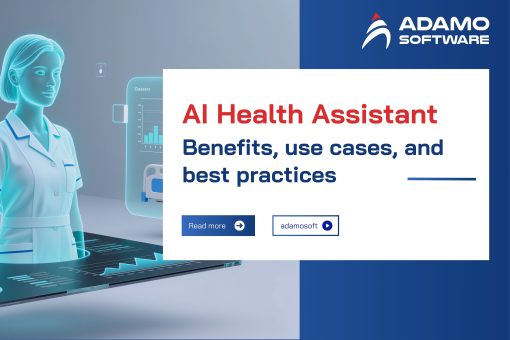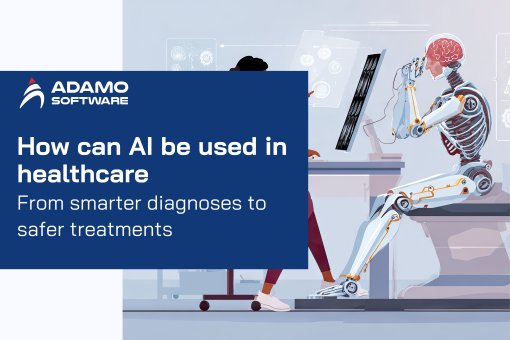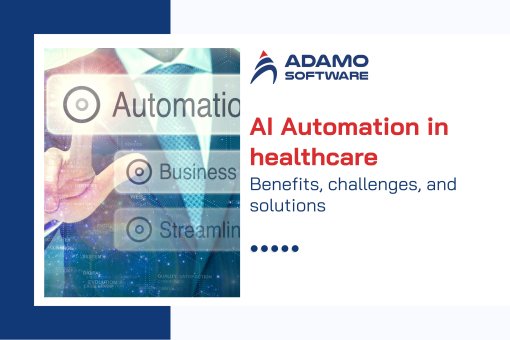A definitive guide on developing EHR integration software (2026 updated)

As the development of healthcare institutions continues, the role of organizing and managing patient data is becoming more evident. EHR integration software can contribute to this goal. It connects several EHRs and other healthcare applications. This integration helps medical professionals flow patient information while increasing the efficiency of the data.
The EHR integration system is used to tackle problems arising from different systems. It creates an integrated system to access patient records. EHR integration software is crucial for enhanced patient care management and reduced mistakes. Overall, EHR integration software increased work productivity. However, for better EHR integration software, the following ideas and requirements must be noted.
This guide will provide all the information you need to create EHR integration software. Here, it will be possible to discuss the distinction between EMR and EHR systems. We will also discover various forms of EHR software integration and some noteworthy factors. Further, we will explore the issues during the development process, the technical stacks, and the roles and responsibilities of the development team. You can design and deploy more effective EHR integration software and boost your healthcare business.
I. EMR and EHR: Key differences
Since EMR and EHR may need integration while designing the EHR integration software, the distinction between them is crucial. Here are the key distinctions:
1. Scope and Functionality
- EMR (Electronic Medical Record): EMR in healthcare is electronic record. It is within a specific healthcare facility or a practice. EMRs offer a detailed record of the patient within a practice. The practice includes the diagnoses made, the treatments offered, and the medications prescribed.
- EHR (Electronic Health Record): Electronic Health Records are more comprehensive. It is integrated with other healthcare organizations’ databases. They encompass the clinical narrative of a patient’s health status and information from different caregivers and settings.
2. Data Sharing and Interoperability
- EMR: Generally, EMRs are not for records with practices other than the patient’s. They are intended for the healthcare provider to organize patient care in its setting.
- EHR: Those integrated EHRs enable certain levels of data exchange between healthcare organizations. This capability is critical in determining the patient’s need for coordinated care and requesting data from the caregivers.
3. Purpose and Usage
- EMR: The role of an EMR is to optimize the processes and procedures inherent to a practice. EMR is convenient for monitoring patients’ data and facilitating clinical choices within that environment.
- EHR: EHRs are expected to enhance patient care in the health sector, from diagnosis to disease treatment. These allow better capture and utilization of data that informs decisions and client care.
4. Patient Access
- EMR: Patients cannot access the EMRs and rely on the healthcare facility’s personnel to get the information. It is aimed at practicing healthcare professionals.
- EHR: In many EHR systems, patient portals can be accessed. This enables an individual to access their information and get the test results. Among other features is communication with clinicians.
It is necessary to consider such differences to design good EHR integration software. This means that the software should meet the specifications of both EMRs and EHRs to share data between various systems and practices.
II. Types of EHR software integration
Considering the creation of EHR integration software, one must consider all types of EHR software integration. These types are crucial in data exchange and catheterization among multiple healthcare systems. Here are the main types:
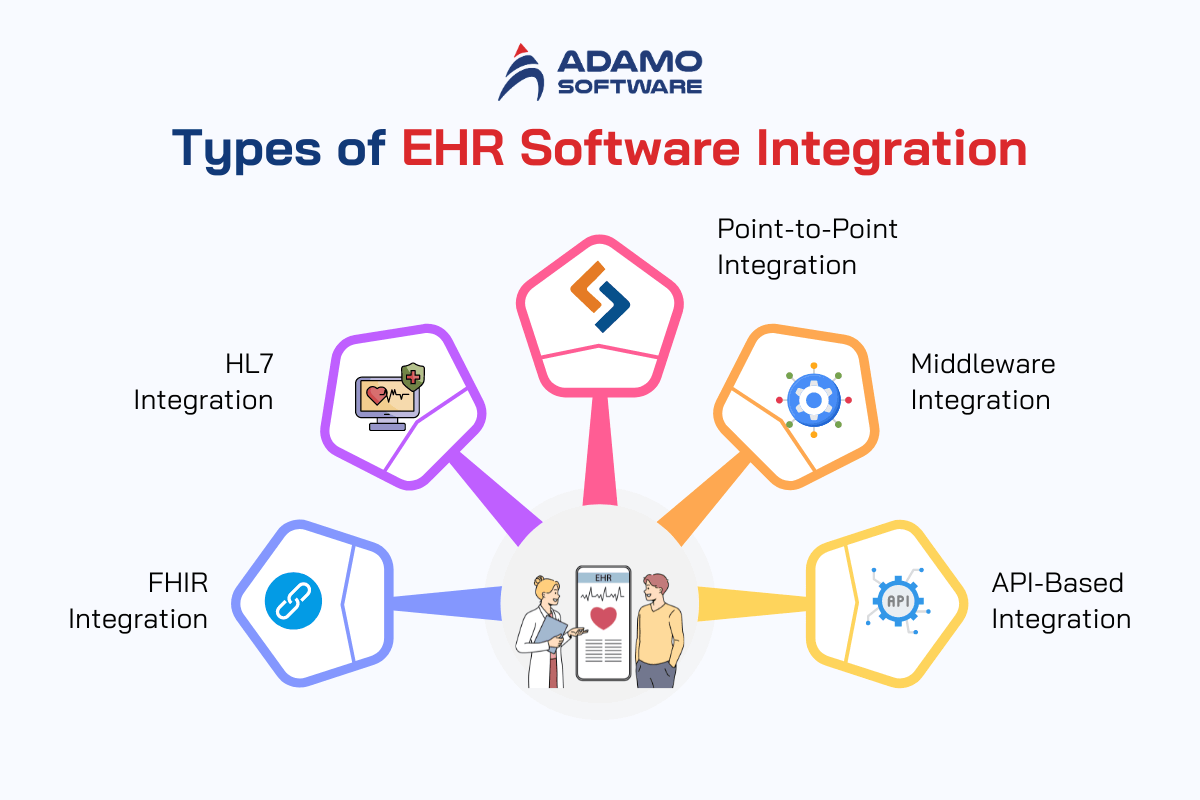
1. Point-to-Point Integration
This type of integration links two systems so that they can communicate directly with each other. For instance, an EHR system might be connected to a laboratory testing system to get automatic results.
- Advantages: Point-to-point integration is simple to implement. It is ideal for simpler scenarios where only a few systems are interacting.
- Limitations: It becomes challenging to have one point-to-point connection when the number of systems connected grows.
2. Middleware Integration
Middleware works between two or many systems to provide an interface for their interaction. They sometimes employ a common data model for an EHR system or other applications interfacing with it.
- Advantages: Middleware reduces externally oriented aspects of integration. It centralizes the data exchange, lowers the integration needed, and can grow better.
- Limitations: It may be complicated to manage the system and coordinate the services. Consuming more resources for maintenance and administration can also be challenging.
3. API-Based Integration
API can be defined as the techniques used by two or more systems to interact with one another through specific protocols. Thirdly, they provide EHR integration systems with a means to interact with diverse applications and services of other vendors.
- Advantages: APIs can be less rigid and enable real-time data sharing. Coinciding is crucial for adopting contemporary applications of services within EHR systems.
- Limitations: it interacts with other APIs, and its management demands high levels of API security and possible versioning.
4. HL7 Integration
Used to exchange healthcare information in electronic format, HL7 stands for Health Level 7. HL7 integration also helps to ascertain that EHR integration systems can interface with other healthcare-related structures. Interaction ensures the sending and receiving of predefined messages.
- Advantages: HL7 stands for the seventh health-limited language. It proposes a method of transferring shares of information. The approach can enhance the signal that is shared between systems.
- Limitations: HL7 standards are comprehensive and can be challenging to apply. It might require a lot of customization to apply HL7.
5. FHIR Integration
FHIR, or Fast Healthcare Interoperability Resources, is a more current way of sharing common healthcare data. The following are the benefits associated with the integration of FHIR. FHIR integration enables EHR integration systems to connect with others using a more flexible and web-oriented approach.
- Advantages: Data can be exchanged using several data formats compatible with FHIR. It can also increase notable data exchange among the most common systems. It is also easier to implement and use when compared to previous standards.
- Limitations: FHIR is a relatively new standard, it may be necessary to make changes frequently during the integration process. Since the long-term updates and changes to the standard are permanent.
Knowledge of EHR integration software is important. It is crucial to understand that each integration type has advantages and limitations. The selection of the integration approach will critically depend on the existing conditions. Therefore, if done correctly, EHR integration software presents a signal boost in healthcare efficiency and efficacy.
III. Fundamental features to apply in EHR Software
When designing EHR integration software, it is essential to include amiable features to make the new system workable. Here are some features to consider:

1. Interoperability
The EHR system can transmit and use information with other EHR systems. It is crucial for the interconnection between different systems and between the information inputs and outputs.
It enhances quality patient care by offering a patient-integrated record from various healthcare providers. EHR integration software needs to interface with plenty of other systems. Therefore, it must be easy to integrate.
2. User-Friendly Interface
Easy to use to avoid confusing healthcare professionals. The others encompass simplicity of layout and structure, proper organization, and ease of use.
The users are satisfied with the shorter learning time and better-developed interface. A factor in the success of EHR integration software is the practicality of daily operations and production.
3. Clinical Decision Support
Clinical Decision Support (CDS) provides evidence-engaged practice choices, notifications, and instructions. They assist in making good decisions that have more positive impacts and improve the lives of many patients.
CDS features can enhance the quality of care and are related to error minimization. When CDS is integrated into the EHR integration software, better decision-making and better health outcomes are attainable.
4. Data Security and Privacy
Security measures guard patients’ information from theft and loss to forestall compromise of the patient’s data. Some measures include encryption embrace, user access controls, and industry standards adoption like the Health Insurance Portability and Accountability Act.
Security of the patient’s data is of the utmost importance and priority. For proper EHR integration software, security features must not be compromised.
5. Customizable Reporting and Analytics
Flexible-generated and analyzing systems enable users to create and examine the report, considering the necessities. The organization can identify factors that influence its performance. Hence, they can monitor the performance.
It assists healthcare facilities in evaluating their performance, controlling resources, and studying patterns. Integrating these tools into EHR integration software makes them useful for different software analyses.
6. Scalability
Security also plays a vital role in ensuring that all the data in the EHR system is protected from unauthorized access. Compatibility assesses that the present EHR system can be implemented in future healthcare organizations. This entails satisfying more users, data, and functionalities.
A scalable system enables an organization to continue using it in the future as the need increases. The EHR integration system needs to be scalable in response to the constant change in most organizational settings.
7. Patient Portal Integration
Patient portals give patients control of their health information, scheduled appointments, and how to communicate with their health teams.
It means that patients become more involved directly in the care process. The overall level of patients’ participation is enhanced. This feature improves patient satisfaction to enhance the EHR integration software.
These functionalities ensure that EHR integration software is functional and secure. All the mentioned features are crucial for providing an effective and user-oriented system.
IV. Factors to consider while building an Integrated EHR Systems
Several factors must be considered when designing EHR integration software. They ensure that the software works in adaptable and fulfills the needs of the healthcare industry. Here are important factors to consider:
1. Data Interoperability
Interoperability means the exchange and use of information between two or more systems. In the case of full-blown integrated EHR systems, they should be able to interface with others in the broader healthcare sector and software.
Data sharing makes EHR integration software more useful. While retaining data in a single entity, those data are easier to input and pass on. The main aim of EHR is to facilitate better coordination of patient care. It assists in designing a harmonized view of patients’ records across various paradigms.
2. Compliance with Regulations
EHRs, like other healthcare records, cannot afford to ignore healthcare regulations and standards like HIPAA. This includes addressing issues to do with data protection, privacy, and patient rights.
They include the protection of patient data and legal issues. Compliance therefore plays an important role in ensuring that legal problems are followed. So that the patient’s data is not compromised. An EHR integration software also needs to cater to these regulations and be able to satisfy patients’ trust issues.
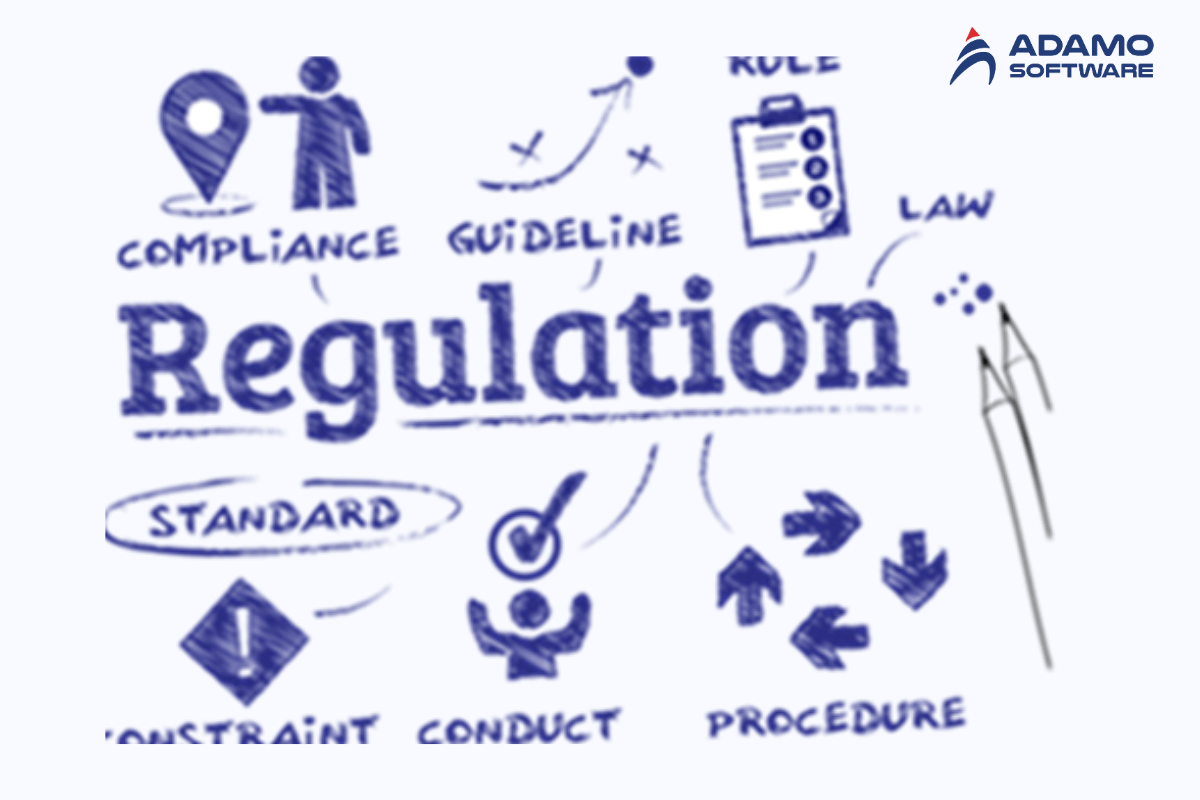
3. System Scalability
In other words, scalability involves the capacity of the system to handle growing size, varied population, and new applications and features.
Hence, one needs to define features that guarantee that the EHR system is scalable to suit the needs of the facilities in the long run. Integration and software scalability are incorporated to address anticipated growth and other changes in healthcare needs.
4. User Experience and Interface Design
The EHR UI and the major overall experience from a user perspective highly influence EHR system performance. It should be an intuitive design and simple to navigate for the healthcare professional.
Sophisticated or complex interfaces displayed ease to boost productivity, hence being recognized as an effective UI/UX design. This incorporates user experience into EHR integration software. It also ensures that the users can optimally and efficiently operate the software.
5. Data Security and Privacy
Measures must be taken to safeguard patient data to prevent exposure and unauthorized access to the information. This involves data protection, what can be referred to as the secure socket layer, secure user login, and constant security upgrades.
Data security is crucial to retaining the patient’s confidence and for legal reasons. An effective EHR integration software must include security elements that protect clients’ information.
6. Integration with Existing Systems
Some of the critical developments include the questions of how the EHR system relates to other healthcare systems such as LIS and RIS.
Interoperability guarantees relative compatibility with other systems. Thus, it enables the EHR system to share information with others. It improves the performance of functional aspects of EHR integration software and optimizes processes.
7. Data Migration and Management
Data conversion is where patients’ records from the former system are copied to the new EHR system. Like any other information, the data should be managed and validated to avoid missing out or having false information.
It is crucial to address properly the issues related to data migration and management to allow the transition to the new system. This determines how the initial EHR integration software implementation is done and its success.
8. Technical Support and Training
A proposal for sufficient technical support and training of the users plays a key role in the EHR integration system. This reference was provided, and the tools were made available for technical help and installation of new systems.
Ensuring the user is well supported and trained ensures he or she masters his or her way around the system and problems. This factor improves the application and implementation of EHR integration software in daily activities.
These factors help ensure that EHR integration software is optimized for use, lawful, and effective. Alleviating these aspects is a way of enhancing the implementation and functionality of the integrated EHR systems.
V. How to build an EHR integration software: Tech stacks and team required
There is a need to choose the appropriate technological environment and negotiate a suitable team for EHR integration software. Here’s how you get through the process:
1. Define the Tech Stack
- Programming Languages
There is a relationship between the programming languages used in software development and the efficiency or ease of software maintenance. Java, Python, and C# are common options for implementing software. Java is recognized for its scalability. Python is known for having simple code. C# is favored for integrating Microsoft products.
- Database Management Systems (DBMS)
A DBMS that can handle patients’s records and data integrity is essential in EHR integration software. Choose a DBMS that can handle large amounts of health data and has provisions for safe storage. Here are some of the most widely used ones: PostgreSQL, MySQL, and MS SQL servers.
- APIs and Integration Tools
APIs enable data exchange and integration in EHR software. They are essential for EHR systems to communicate with other healthcare applications. Adopt API integration tools for this purpose. Frequently used standards include FHIR and HL7.
- Cloud Platforms
Cloud platforms sustain growth and performant EHR software. This is due to the facilities available within virtual environments. Consider using cloud solutions like AWS, Azure, or Google Cloud. These services are elastic and can accommodate changes in loads.
2. Assemble the Development Team
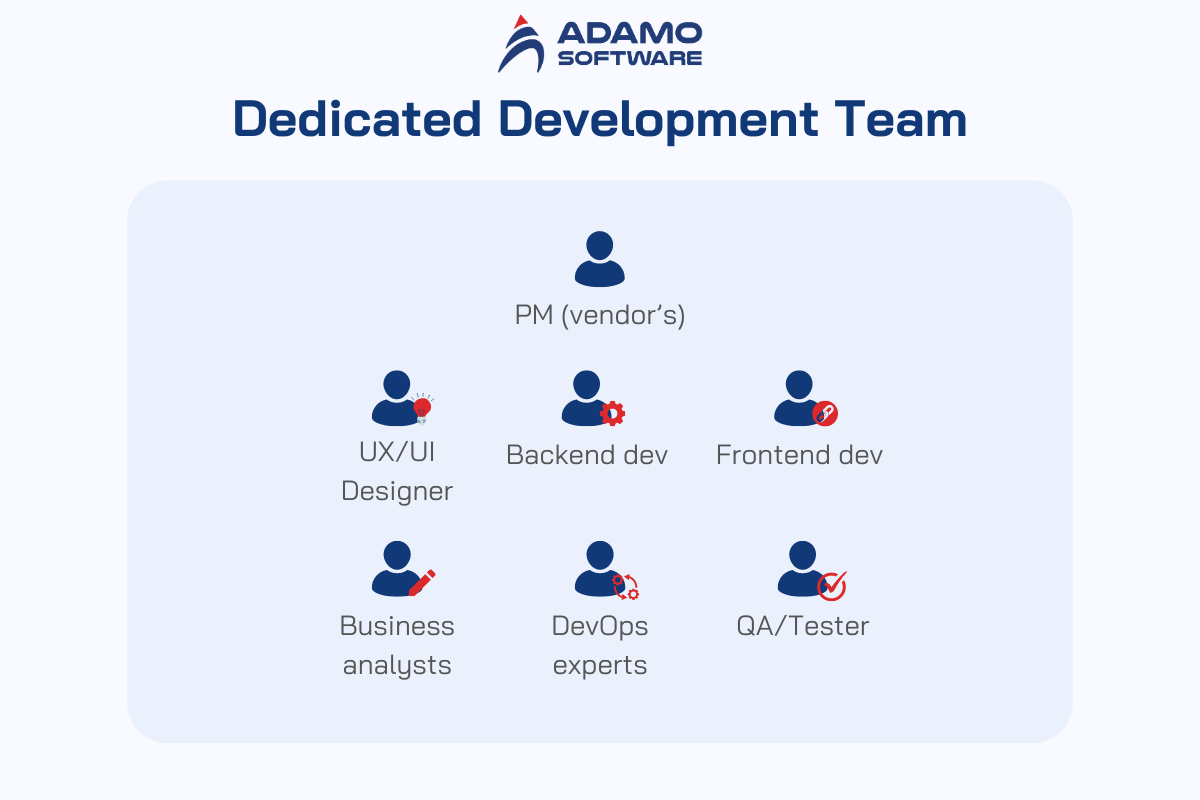
- Project Manager
A project manager is responsible for a team and its timeline and guarantees the successful implementation of EHR integration software. They supervise the development process. They are responsible for scheduling and the alignment corresponding with the objectives set by the client.
- Software Developers
It requires skilled developers to create and sustain the platforms for EHR integration and provide structure and support for its core activities. Develop the EHR system software in conjunction with the associated code. Programmers should have prior knowledge of the selected programming languages and technologies.
- System Architects
System architects develop a plan that can be expanded and optimized. This is crucial in how the software will run and be integrated. Manage the overall system design and design for interfaces with other systems where the software is placed.
- Quality Assurance (QA) Testers
QA testers play a major role in reducing the shortcomings in EHR integration software before it is deployed. Perform trials to assess and correct malfunctions to ensure software conforms to industry standards.
- Database Administrators (DBAs)
DBAs are responsible for protecting patient data and the effective functioning of EHR integration software. Custodians and caregivers of the database are responsible for data security, backups, and recoveries.
- UX/UI Designers
Improvements in the UX/UI design make the EHR integration software easier to use for healthcare professionals. Develop a user interface and ensure that all the programs or applications created are easy for target users.
- Integration Specialists
Integration specialists ensure EHR integration software speaks to other systems for smooth information exchange. Coordinate the interfacing of the EHR system with others.
3. Development Process
- Requirement Analysis
It is also important to set clear requirements to control the development and to achieve a result that meets the requirements. Recollect and analyze the requests from stakeholders to gain the desire and purpose for the EHR integration software.
- Design and prototyping
Prototyping enhances the system’s functionality and user interaction. It occurs before the actual development of the whole system. Use documentation and models to illustrate the system. Convey the ideas of different stakeholders effectively.
- Development and Coding
Coding and implementing features for EHR integration is essential. Develop the software code according to design requirements. Fix different parts of the software as needed.
- Testing and Quality Assurance
The testing process guarantees that tools and software for EHR integration are reliable and prepared for implementation. Run tests on the established options to ensure that any glitches are arrested. Make sure the software produced conforms to good quality and contributes to its reliability.
- Deployment and Maintenance
Having deployed and maintained computer software keeps the integration software running and updated. The software is installed on the production environment and post-installation support and maintenance.
When the right technologies are chosen, and the appropriate team is hired, high-quality EHR integration software can be created. It will be compatible with the needs of healthcare organizations.
VI. How can Adamo help with your EHR project?
Here, Adamo Software offers descriptions of all the support we can provide to EHR integration software developers. Let’s discover how Adamo assists with your project:

1. Expert Consultation
Adamo Development has highly skilled personnel. We can help identify the objectives, goals, and specifications of your EHR integration. Our team will assist with planning to ensure a satisfactory result that meets your needs.
Consulting experts provide a detailed plan for your EHR integration. This ensures success with the project and the goals, according to industry standards.
2. Custom Integration Solutions
Adamo works with you to determine and build what you need with EHR integration solutions. This includes interfacing with other systems to enable interfacing with others for data sharing.
The EHR integration software is tailored to your specifications. It meets the needs of your healthcare facility and complements other integrated systems.
3. Technical Expertise and Support
Adamo offers the management and hiring of a qualified team of developers, system architects, and integration experts. Adamo ensures technical support from the start.
Regarding the technical expertise of the EHR integration software, your software is developed based on the latest technologies implemented in the industry.
4. Compliance and Security
Adamo makes sure your EHR integration software is HIPAA compliant and follows other health laws and policies of security. This entails preserving the patient’s information and meeting all the standards within the sector.
Adherence to compliance and security is important. This protects sensitive information and the legal and regulatory permitting of the EHR integration software.
5. Ongoing Maintenance and Support
Closely related to maintenance, Adamo offers continuing servicing after its products are deployed. This makes it possible to conduct issues, updates, and checks to ensure the software runs efficiently.
Ensuring the EHR integration software is always functional requires frequent maintenance and support. This is essential for long-term success.
6. Scalability and Future-Proofing
Adamo makes EHR integration software with the flexibility in mind that would allow it to expand in the future.
Scalability makes your EHR integration software adaptable to bigger volumes of data or other needs, making it more sustainable software.
FAQs
1. Why is EHR integration software important?
EHR integration is necessary for healthcare to become more coordinated in inpatient delivery. It reduces data silos by enabling systems to interact. This integration improves patient care, reduces error rates, and enhances administration.
2. What should I consider when selecting EHR integration software?
When selecting EHR integration software, consider compatibility, legal requirements governing the use of Health Information Exchange, data security, and expansion capacity. Make sure that will enable it to fulfill the current needs that you have in addition to future needs.
3. What are the benefits of using EHR integration software?
EHR integration software offers benefits like effective data handling, strong collaboration, better productivity, and non-negligible compliance with state standards. It creates a wider perspective of patient information, improving health outcomes.
4. How can I ensure the success of my EHR integration software project?
Select the right healthcare software development vendor, such as Adamo, to increase the chance of successful EHR integration software. Identify the project requirements and ensure compliance with established standards and security features. Further, the effectiveness of integration should be supported by regular testing processes and further support.
5. How does Adamo assist with EHR integration software projects?
Adamo provides full support for practices considering or currently in the process of implementing EHR integration software. We offer consultancy, development services, tailored products, and technical help. We guarantee compliance with health care rules if necessary. Adamo also supports the software and ensures it can be easily expanded and secured.







